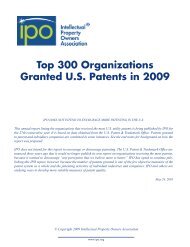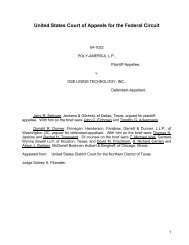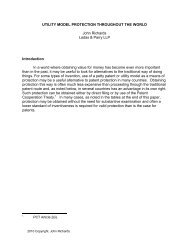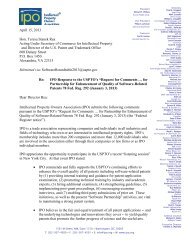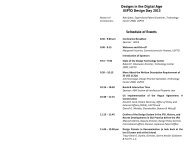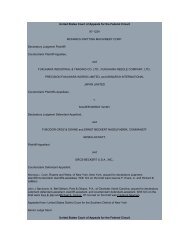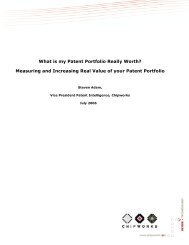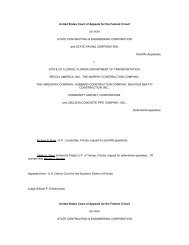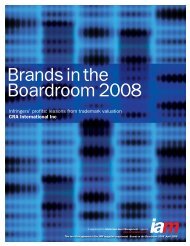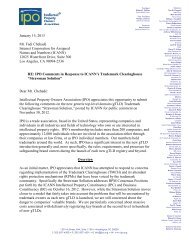a model order limiting excess patent claims and prior art
a model order limiting excess patent claims and prior art
a model order limiting excess patent claims and prior art
You also want an ePaper? Increase the reach of your titles
YUMPU automatically turns print PDFs into web optimized ePapers that Google loves.
A MODEL ORDER LIMITING EXCESS<br />
PATENT CLAIMS AND PRIOR ART<br />
Although cost-effective <strong>patent</strong> enforcement is vital to innovation, <strong>patent</strong><br />
litigation has become increasingly expensive. 1 Courts <strong>and</strong> the <strong>patent</strong> bar have<br />
attempted to control the cost <strong>and</strong> complexity of <strong>patent</strong> cases with some success.<br />
The adoption of <strong>patent</strong> rules in many jurisdictions, beginning in 2000, has<br />
improved predictability in <strong>patent</strong> case management. 2 More recently, the Federal<br />
Circuit Advisory Council’s E-Discovery Model Order has helped reduce the<br />
problem of <strong>excess</strong>ive e-discovery costs. 3 But problems persist.<br />
In many <strong>patent</strong> cases, the sheer number of issues presented can be<br />
overwhelming. According to one study, litigated <strong>patent</strong>s contain an average of 24<br />
<strong>claims</strong> <strong>and</strong> cite 31 <strong>prior</strong> <strong>art</strong> references. 4 There is a consensus that the numbers of<br />
asserted <strong>claims</strong>, claim terms, <strong>and</strong> <strong>prior</strong> <strong>art</strong> references in <strong>patent</strong> cases are often<br />
problematically <strong>excess</strong>ive. Cases with over a hundred asserted <strong>claims</strong> <strong>and</strong> over a<br />
hundred asserted <strong>prior</strong> <strong>art</strong> references during discovery are common. The<br />
identification of an unmanageable number of products can be a problem too.<br />
Lack of discipline by the asserting p<strong>art</strong>y in preparing its case is often why<br />
<strong>excess</strong> issues are maintained. The inclusion of superfluous <strong>claims</strong> <strong>and</strong> <strong>prior</strong> <strong>art</strong> can<br />
function to “hide the ball.” The result is an asymmetric burden on the responding<br />
p<strong>art</strong>y (<strong>and</strong> the trial court) because the asserting p<strong>art</strong>y often has a better sense of<br />
which issues it will ultimately pursue.<br />
Excess issues, unsurprisingly, inflate litigation costs. Each unnecessary<br />
asserted claim <strong>and</strong> <strong>prior</strong> <strong>art</strong> reference must be analyzed <strong>and</strong> ch<strong>art</strong>ed, among a<br />
1 See Emery G. Lee III & Thomas E. Willging, Litigation Costs in Civil Cases: Multivariate<br />
Analysis 8 (Fed. Judicial Ctr. 2010) (“Intellectual Property cases had costs almost 62% higher,<br />
all else equal, than the baseline ‘Other’ category.”); AIPLA Report of the Economic Survey 2011<br />
at 35–36 (average cost of a <strong>patent</strong> litigation with more than $25 million at risk is $6 million).<br />
2 See James Ware & Brian Davy, The History, Content, Application <strong>and</strong> Influence of the<br />
Northern District of California’s Patent Local Rules, 25 Santa Clara Computer & High Tech.<br />
L.J. 965 (2009).<br />
3 See Federal Circuit Advisory Council, An E-Discovery Model Order,<br />
http://www.cafc.uscourts.gov/images/stories/announcements/Ediscovery_Model_Order.pdf.<br />
4 See John R. Allison, Mark A. Lemley & Joshua Walker, Extreme Value or Trolls on Top? The<br />
Characteristics of the Most-Litigated Patents, 158 U. Penn. L. Rev. 1 (2009).
myriad of other unnecessary case-management tasks that follow. These attorney<br />
chores generate disputes, frequently unrelated to the merits, which unduly burden<br />
the judiciary. The per-case resources a busy judge can afford to invest in a <strong>patent</strong><br />
case is only a fraction of what the p<strong>art</strong>ies <strong>and</strong> their law firms are willing to expend.<br />
Focusing <strong>patent</strong> cases to the issues at the core of the dispute will reduce the<br />
burden on courts <strong>and</strong> lower the expense for the p<strong>art</strong>ies. In addition, a greater focus<br />
on the true issues will improve the quality of the adjudicatory process for all.<br />
THE MODEL ORDER<br />
Many courts have issued <strong>order</strong>s <strong>limiting</strong> the number of <strong>claims</strong> <strong>and</strong> <strong>prior</strong> <strong>art</strong><br />
references in <strong>patent</strong> cases on an ad hoc basis. Given the potential benefits of such<br />
<strong>order</strong>s for litigants <strong>and</strong> the courts alike, it is surprising that courts do not issue such<br />
<strong>order</strong>s more routinely, <strong>and</strong> that there is no systematic approach to this issue.<br />
Recent Federal Circuit authority, including In re Katz Interactive Call Processing<br />
Patent Litigation, 639 F.3d 1303 (Fed. Cir. 2011), has validated this practice <strong>and</strong><br />
galvanized interest in this case management tool.<br />
After reviewing existing authority, <strong>and</strong> drawing on collective experience, the<br />
Committee has prepared the attached Model Order, which has been unanimously<br />
approved by the Advisory Council. The Committee considered several key issues:<br />
What. What should be limited—number of <strong>claims</strong>, number of <strong>prior</strong> <strong>art</strong><br />
references, number of invalidity theories, number of terms for claim<br />
construction, number of accused products, or some combination?<br />
Timing. When should the limits on asserted <strong>claims</strong> <strong>and</strong> <strong>prior</strong> <strong>art</strong> references<br />
take effect? Should the limits be applied only once, or should a phased<br />
approach gradually narrowing the scope of the case be followed? How<br />
should the need for discovery be balanced against the value of early<br />
streamlining?<br />
Limitations. How should limits be formulated? Should the limits on<br />
number of <strong>claims</strong> apply per case or per <strong>patent</strong>? How should the limits be<br />
adjusted based on the variety of case-specific factors that courts have<br />
considered? How can the due process rights of litigants be protected?<br />
Effect. What effect does the judgment have on non-elected <strong>patent</strong> <strong>claims</strong><br />
<strong>and</strong> <strong>prior</strong> <strong>art</strong> references?<br />
2
The Model Order reflects the Committee’s conclusion that default numerical<br />
limits on the number of asserted <strong>patent</strong> <strong>claims</strong> <strong>and</strong> <strong>prior</strong> <strong>art</strong> references are<br />
workable. Furthermore, to balance the need for discovery against the benefits of<br />
early streamlining, the Committee settled on a phased implementation of these<br />
numerical limits.<br />
Two logical points for imposing limits were chosen to maximize efficiency<br />
while preserving the ability of the p<strong>art</strong>ies to make informed choices about which<br />
<strong>claims</strong> <strong>and</strong> <strong>prior</strong> <strong>art</strong> to assert: (1) after production of “core” technical documents<br />
but before claim construction, <strong>and</strong> (2) after claim construction but before expert<br />
reports. In this respect, the Model Order complements the Federal Circuit<br />
Advisory Council’s Model E-Discovery Order, which promotes streamlined “core”<br />
technical discovery early in the case. In addition, the Model Order complements<br />
<strong>patent</strong> case schedules that provide for claim construction during discovery <strong>and</strong><br />
expert reports after claim construction. But the Model Order can apply, with<br />
appropriate adjustments, to <strong>patent</strong> cases managed with differing schedules.<br />
The Committee hopes this Model Order serves as a useful tool for effective<br />
case management <strong>and</strong> that it encourages the productive discussion of this topic.<br />
The improvement of <strong>patent</strong> litigation is a work-in-progress. Others may well see<br />
fit to modify, evolve or exp<strong>and</strong> this <strong>model</strong>.<br />
Moreover, because it is a <strong>model</strong>, the <strong>order</strong> may not fit all circumstances <strong>and</strong><br />
customization is certainly appropriate. As p<strong>art</strong> of case-specific tailoring, this<br />
<strong>order</strong> may be coupled with other case management tools such as the use of binding<br />
“representative <strong>claims</strong>.” See P<strong>and</strong>uit Corp. v. Dennison Mfg. Co., Inc., 836 F.2d<br />
1329, 1331 (Fed. Cir. 1987) (“The term "representative <strong>claims</strong>" is well understood<br />
in <strong>patent</strong> litigation, <strong>and</strong> the procedure followed in this trial is familiar to any<br />
experienced <strong>patent</strong> litigator.”). As an example, the desire for a comprehensive<br />
injunction might make representative <strong>claims</strong> a useful procedure to consider.<br />
The Committee recognizes that there are problems beyond those addressed<br />
in this <strong>model</strong> <strong>order</strong> that deserve study because they too can bloat <strong>patent</strong> cases.<br />
This includes the quality of the complaints that are based on Form 18 to the<br />
Federal Rules of Civil Procedure <strong>and</strong> unwieldy product identifications that include<br />
a multitude of products without the rational selection of representative products.<br />
While there certainly are cases that may well warrant limits <strong>and</strong> other remedies in<br />
these areas, for simplicity this <strong>model</strong> <strong>order</strong> is focused on the broad <strong>and</strong> compelling<br />
need to responsibly limit <strong>claims</strong> <strong>and</strong> <strong>prior</strong> <strong>art</strong> assertions in appropriate cases.<br />
3
Model Order Committee<br />
Chief Judge R<strong>and</strong>all Rader (Fed. Cir)<br />
Chief Judge Leonard Davis (E.D. Tex)<br />
Judge Theodore Essex (ITC)<br />
Judge Katherine Forrest (S.D.N.Y.)<br />
Judge Lucy Koh (N.D. Cal.)<br />
Tina Chappell<br />
Morgan Chu<br />
Sean Cunningham<br />
Isabella Fu<br />
Mike McKool<br />
Edward Reines (Chair)<br />
John Whealan<br />
Ably assisted by Kori Anne Bagrowski <strong>and</strong> Nathan Greenblatt<br />
4
Addendum: Model Order<br />
Case No.: ____<br />
Plaintiff,<br />
v.<br />
Defendant.<br />
[MODEL] ORDER LIMITING EXCESS<br />
PATENT CLAIMS AND PRIOR ART
The Court ORDERS 1 as follows:<br />
1. This Order supplements all other discovery rules <strong>and</strong> <strong>order</strong>s. It<br />
streamlines the issues in this case to promote a “just, speedy, <strong>and</strong> inexpensive<br />
determination” of this action, as provided by Federal Rule of Civil Procedure 1.<br />
Phased Limits on Asserted Claims <strong>and</strong> Prior Art References<br />
2. Not later than 40 days after the accused infringer is required to<br />
produce documents sufficient to show the operation of the accused<br />
instrumentalities, the <strong>patent</strong> claimant shall serve a Preliminary Election of Asserted<br />
Claims, which shall assert no more than ten <strong>claims</strong> from each <strong>patent</strong> <strong>and</strong> not more<br />
than a total of 32 <strong>claims</strong>. Not later than 14 days after service of the Preliminary<br />
Election of Asserted Claims, the <strong>patent</strong> defendant shall serve a Preliminary<br />
Election of Asserted Prior Art, which shall assert no more than twelve <strong>prior</strong> <strong>art</strong><br />
references against each <strong>patent</strong> <strong>and</strong> not more than a total of 40 references. 2<br />
1 The p<strong>art</strong>ies are encouraged to discuss limits lower than those set forth in this Model Order<br />
based on case-specific factors such as commonality among asserted <strong>patent</strong>s, the number <strong>and</strong><br />
diversity of accused products, the complexity of the technology, the complexity of the <strong>patent</strong><br />
<strong>claims</strong>, <strong>and</strong> the complexity <strong>and</strong> number of other issues in the case that will be presented to the<br />
judge <strong>and</strong>/or jury. In general, the more <strong>patent</strong>s that are in the case, the lower the per-<strong>patent</strong><br />
limits should be. The p<strong>art</strong>ies shall jointly submit any proposed modifications in their Federal<br />
Rule of Civil Procedure 26(f) Discovery Plan.<br />
2 For purposes of this Order, a <strong>prior</strong> <strong>art</strong> instrumentality (such as a device or process) <strong>and</strong><br />
associated references that describe that instrumentality shall count as one reference, as shall the<br />
closely related work of a single <strong>prior</strong> <strong>art</strong>ist. In cases involving several <strong>patent</strong> families or diverse<br />
technologies, or disparate <strong>claims</strong> within a <strong>patent</strong>, the court should consider flexibly whether<br />
circumstances warrant exp<strong>and</strong>ing the limits on <strong>prior</strong> <strong>art</strong>.
3. Not later than 28 days after the Court issues its Claim<br />
Construction Order, the <strong>patent</strong> claimant shall serve a Final Election of Asserted<br />
Claims, which shall identify no more than five asserted <strong>claims</strong> per <strong>patent</strong> from<br />
among the ten previously identified <strong>claims</strong> <strong>and</strong> no more than a total of 16 <strong>claims</strong>.<br />
Not later than 14 days after service of a Final Election of Asserted Claims, the<br />
<strong>patent</strong> defendant shall serve a Final Election of Asserted Prior Art, which shall<br />
identify no more than six asserted <strong>prior</strong> <strong>art</strong> references per <strong>patent</strong> from among the<br />
twelve <strong>prior</strong> <strong>art</strong> references previously identified for that p<strong>art</strong>icular <strong>patent</strong> <strong>and</strong> no<br />
more than a total of 20 references.<br />
4. If the <strong>patent</strong> claimant asserts infringement of only one <strong>patent</strong>,<br />
all per-<strong>patent</strong> limits in this <strong>order</strong> are increased by 50%, rounding up.<br />
Modification of this Order<br />
5. Upon a showing of diligence, <strong>and</strong> with due consideration for<br />
prejudice, a p<strong>art</strong>y may seek to modify this <strong>order</strong> for good cause shown. Any<br />
request to increase the limits contained in this <strong>order</strong> must specifically show why<br />
the inclusion of additional asserted <strong>claims</strong> or <strong>prior</strong> <strong>art</strong> references is warranted. See<br />
In re Katz Interactive Call Processing Patent Litig., 639 F.3d 1202, 1312–13 (Fed.<br />
2
Cir. 2011). A failure to seek such a modification will constitute acquiescence to<br />
the limits contained in this Order. 3<br />
3 This Model Order contemplates that the p<strong>art</strong>ies <strong>and</strong> the Court may further narrow the issues<br />
during pretrial proceedings in <strong>order</strong> to present a manageable case at trial.<br />
3



